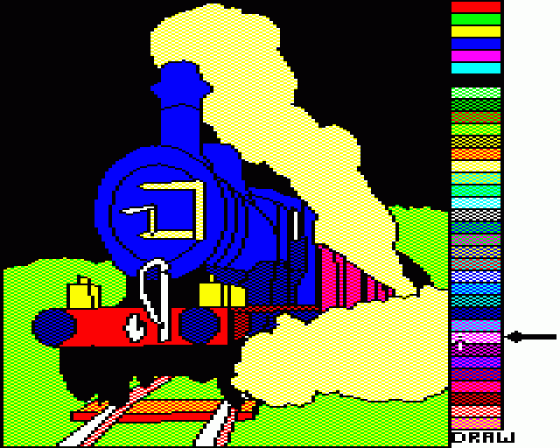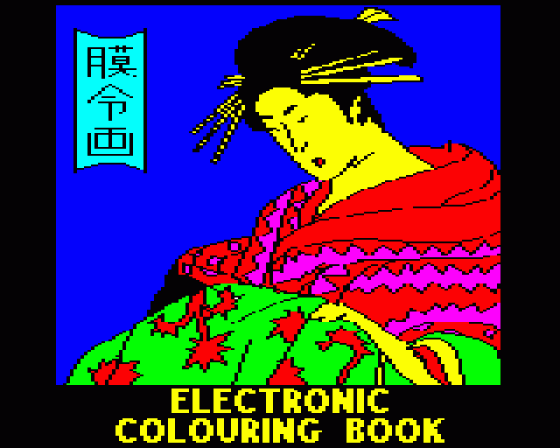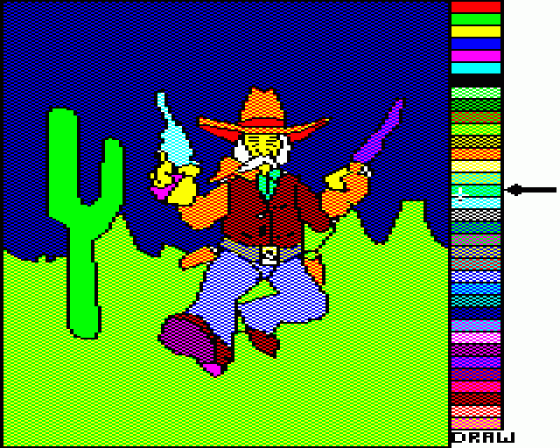
Personal Computer News
 3rd November 1984
3rd November 1984
Categories: Review: Software
Author: Simon Williams
Published in Personal Computer News #085
Become an artist with none of the mess associated with paints and brushes. The Electronic Colouring Book will allow Beeb users to exercise their creativity to the full, says Simon Williams.
COMPUTER CRAYONS
Become an artist with none of the mess associated with paints and brushes. The Electronic Colouring Book will allow Beeb users to exercise their creativity to the full, says Simon Williams
There have been many graphics packages for the BBC Micro, but the Electronic Colouring Book is the first program to specialise in the colouring of pre-defined pictures on a Mode 2 screen. It's a well engineered package with a lot of scope for hours of entertainment, and will appeal to any Beeb user.
Presentation
The package comes with an Acornsoft-style cardboard folder containing a cassette and brief instruction manual. The eight-page booklet gives details of how to run the program, which keys to use and an outline sketch of each of the 18 drawings supplied. It's a pretty easy program to use and the documentation covers all its features well.
Getting Started

To load the program you need to *RUN the first section. The whole thing performs as if written in machine code and loads fairly quickly. The display then blanks to a white background and draws strips of all the available colours in a column down the right hand side of the screen. An arrow indicates which colour is currently selected.
Each palette block could have been larger, as selection with the crosshair cursor was quite awkward on occasions. To load the first drawing the L key is pressed and a name? prompt has to be answered with the appropriate drawing title, obtained from the instruction manual.
The drawing is then built up a block at a time as it's loaded from the cassette. On completion a small cross, the colouring cursor, appears in the centre of the screen. There is no sound to indicate the drawing is complete and, if you don't have remote control on your cassette recorder, you can read on to the next drawing.

Colouring the drawing is simplicity itself - even easier if you use the J key to select joystick control. Otherwise, you have to use the cursor keys, which are programmed to move in big leaps if held down or by a pixel if pressed momentarily. I found the difference between the two modes rather too extreme and was grateful for the proportional joystick to test out the program.
Features
Moving the cursor over any of the coloured bars automatically selects the fill colour, which you then place on the drawing by moving the cursor to the right point and pressing the fire button. The fil routine is very smooth and fast and will cope with any of the irregular areas to be found within the drawings.
There all seem to have been adequately tested to ensure that there are no areas of 'bleed-through', where more of the picture than you intend would be coloured in. The first four drawings come complete with sample colour schemes which may be loaded from the cassette separately from the drawing and show what can be done with the package.
I found the cursor a little jittery in use and it was quite difficult to fill areas when only a few pixels in size. But without filling these areas, annoying white specks were left in the finished picture.
Any area that was filled in error could be rescued by moving the cursor onto it and pressing the D key, whereupon it reverted to the original background colour, normally white. I say normally because it is possible to exchange all elements of white and black in the drawing with a single key press; a peculiar effect.
In addition, the E key will change each colour in turn to another from the palette at intervals of one second. This is done using the Beeb's colour palette and doesn't require the drawing to be refilled. The Q key will stop the process and the R key will restore your original colour scheme.
It's not easy to remove the colour from an entire drawing, but the screen may be cleared with the C command. Once finished the drawing and its colours may be saved to tape from within the program.
It would, therefore, be possible to set up a series of slides for later use. Unfortunately it will still be drawn and coloured in its own time on reloading.
One final feature of the program is the option to draw your own pictures. By selecting the word draw at the base of the colour of colours, the cursor may be moved around, fixed at a point with the fire button and a line 'rubber-banded' from there. Further depressions of the button will fix the new point - it's rather like joining the dots.
New areas may be started by extending the band at any time back to 'draw', when the current line will disappear and the cursor will return. Although very simple, this technique will allow complex original drawings to be built up and coloured in the same way as the pre-defined ones.
Verdict
This is one of the few packages which really does live up to its claim to appeal to young and old alike. I found it quite fascinating and could have spent many more hours doodling away.
Multi-Coloured Modes
It may well have occurred to the more observant reader that the BBC micro is only supposed to have eight colours, ignoring the 'cheat' flashing colours. This is very true, if you rely on the colours available directly from the computer.
At an early stage in its career however, some clever programmer hit upon the idea of simulating extra shades by mixing colours in a pre-defined pattern. This may be made up o falternate horizontal or vertical lines or, as in this case, a chequer of two existing colours.
This words rather better with some combinations than others, but at its best produces tones that are almost indistinguishable in clarity from the 'genuine' colours.
Report Card
Features 4/5
Documentation 4/5
Performance 5/5
Overall Value 4/5



